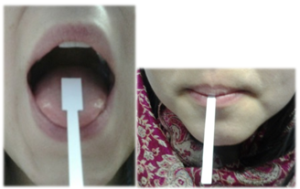Research Methodology
12 Assessing the Ability to Taste and Smell
Several tools exist to test people’s ability to taste and smell. These tests can be used to figure out if someone can take part in research, like taste panels, or to diagnose patients with smell and taste disorders.
measures to assess the ability to taste
The tools assessing the ability to taste and smell are often based on perception thresholds. A difference is made between detection ability, identification ability, and discrimination ability.
The detection ability can be tested by assessing the absolute threshold, the lowest concentration at which a stimulus can be detected but cannot be recognised yet.
The recognition threshold is the concentration at which the stimulus can not only be detected but can also be recognised.
taste tests
Water solutions with different concentration of tastants are often used for taste capability tests. The ability to taste sweetness is usually measured with sucrose (table sugar), sourness with citric acid, saltiness with NaCl (table salt), bitterness with quinine or caffeine, and umami with MSG (monosodium glutamate).
The cut-off values used for lowered taste perception may differ between groups of individuals and different tastes. Taste thresholds for bitter and sour tastants are generally lower than those for the other tastes. Detection thresholds can also differ between tastants for the same taste. For example, the detection threshold for intensive sweeteners is lower compared to sucrose. This can be due to their bitter taste.
Preparing (fresh) taste-water solutions is very labour-intensive and often not very practical in many (clinical or home) situations. Therefore, there are also other tests available. Figure 12 shows a participant tasting a paper strip. This is a standardised test that can be performed at home containing paper strips with tastants standing for the five basic tastes at different levels. Participants need to name if there is a tastant present and if so, name the taste. A low rate of correct identifications may indicate a taste disorder.

SMELL TESTS
Different tests exist to assess a person’s ability to smell[1]. This can be done by smelling odours from a bottle, pen-like dispensers, or scratch and sniff strips. Participants are often blind folded during the test so that they do not know what they are tasting. It helps them also to focus on the smell.
The European Test of Olfactory Capabilities (ETOC) and the sniffing sticks are examples of pen-like dispensers that are used in identification, discrimination and threshold testing[2].
In identification tests, the participant is presented with the odorants one at a time and is asked to name the aroma. This can be done via multiple-choice or open questions.
For discrimination testing, two pens are smelled, and it is asked whether the odours are different. The score is then compared against reference data to decide olfactory function. The odours include of a range of common food odours, such as coffee, mint, orange, vanilla, but also non-food odours such as rose, leather, smoke, and petrol gasoline.
Several scratch and sniff tests exist. For example, a screener of four odours which is used to pre-select people on possible smell loss after which more detailed research can be done. Also, scratch and sniff tests exist with more different odours, varying across the odour spectrum.
The University of Pennsylvania Smell Identification Test (UPSIT) consists of a booklet with 40 scratch-and-sniff strips. The person being tested scratches each strip one at a time to release the scent. A potential participant can smell and select one out of four choices listed next to the strip. The total score is the number of odours correctly named. The score is then compared against reference data to assess olfactory function. These scratch and sniff tests are very convenient as it can be sent to the participants house by mail.
Age-adjusted smell tests exist to test smell capability in children. These tests hold smells that are child-friendly and commonly present in their environment, such as bubble gum, strawberry, chocolate, and banana. Different reference values exist depending on the age and the developmental stage of the child.
Smell tests can also be used to find early indicators of disease, for example, Parkinson’s and Alzheimer’s disease. Sometimes, self-reported loss of smell can also be used as an indicator for disease, for example in COVID-19 cases.
- Parma, V., & Boesveldt, S. (2021). Measurement of olfaction: screening and assessment. Sensory Science and Chronic Diseases: Clinical Implications and Disease Management, 45-63. ↵
- Thomas-Danguin, T., Rouby, C., Sicard, G., Vigouroux, M., Farget, V., Johanson, A., ... & Dumont, J. P. (2003). Development of the ETOC: a European test of olfactory capabilities. Rhinology, 41(3), 134-151. ↵
Lowest concentration at which a stimulus can be perceived.
Lowest concentration at which a stimulus can be recognized.
Concentration at which a change in the detected stimulus can be perceived.
chemical compounds that give taste to food. For example: sucrose, caffeine, MSG, citric acid, NaCl etc.